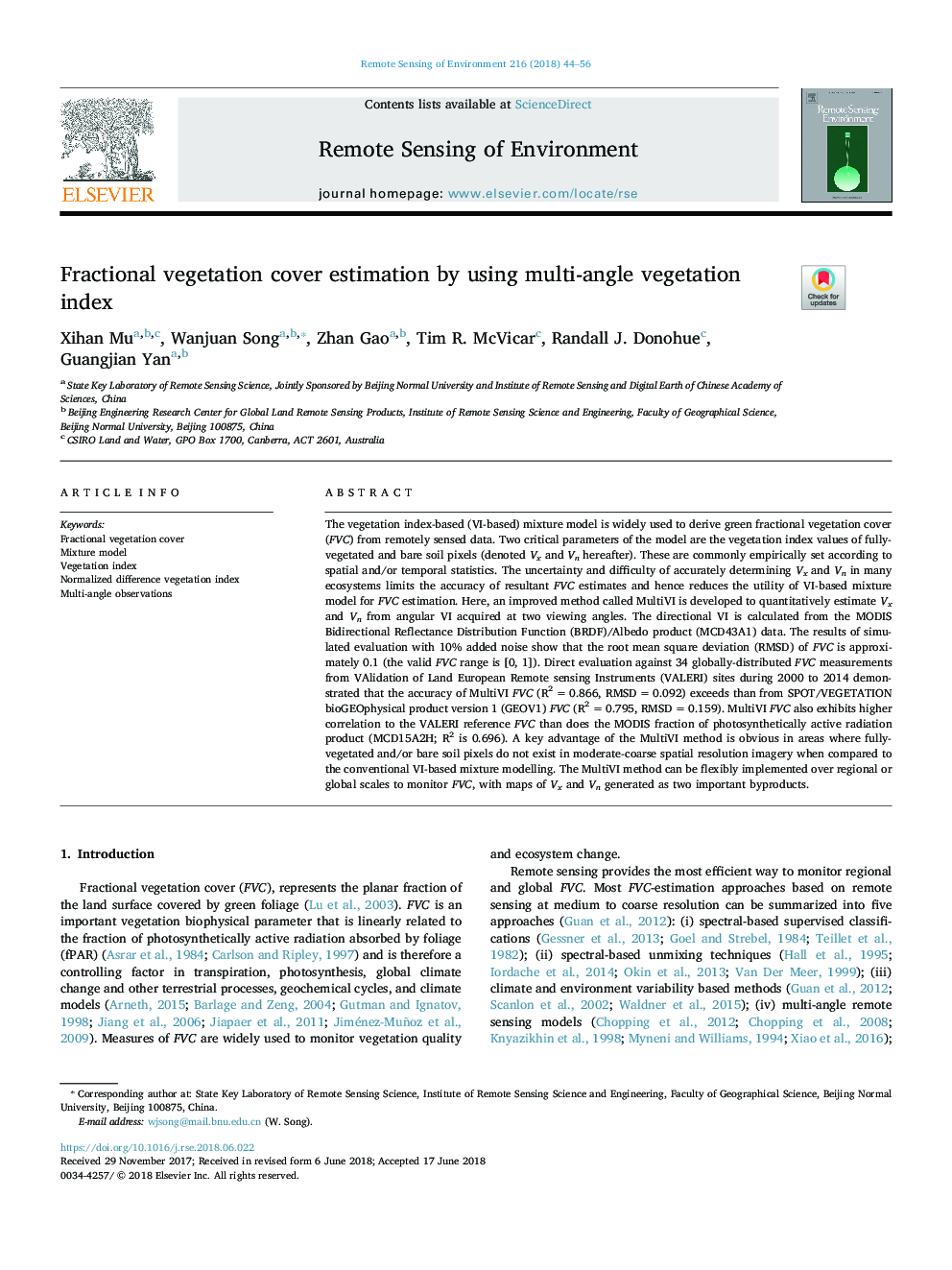| کد مقاله | کد نشریه | سال انتشار | مقاله انگلیسی | نسخه تمام متن |
|---|---|---|---|---|
| 8866401 | 1621184 | 2018 | 13 صفحه PDF | دانلود رایگان |
عنوان انگلیسی مقاله ISI
Fractional vegetation cover estimation by using multi-angle vegetation index
ترجمه فارسی عنوان
تخمین پوشش گیاهی با استفاده از شاخص پوشش گیاهی چند زاویه
دانلود مقاله + سفارش ترجمه
دانلود مقاله ISI انگلیسی
رایگان برای ایرانیان
کلمات کلیدی
پوشش گیاهی مفرط، مدل مخلوط، شاخص رشد گیاه شاخص های پوشش گیاهی استاندارد شده، مشاهدات چند زاویه،
موضوعات مرتبط
مهندسی و علوم پایه
علوم زمین و سیارات
کامپیوتر در علوم زمین
چکیده انگلیسی
The vegetation index-based (VI-based) mixture model is widely used to derive green fractional vegetation cover (FVC) from remotely sensed data. Two critical parameters of the model are the vegetation index values of fully-vegetated and bare soil pixels (denoted Vx and Vn hereafter). These are commonly empirically set according to spatial and/or temporal statistics. The uncertainty and difficulty of accurately determining Vx and Vn in many ecosystems limits the accuracy of resultant FVC estimates and hence reduces the utility of VI-based mixture model for FVC estimation. Here, an improved method called MultiVI is developed to quantitatively estimate Vx and Vn from angular VI acquired at two viewing angles. The directional VI is calculated from the MODIS Bidirectional Reflectance Distribution Function (BRDF)/Albedo product (MCD43A1) data. The results of simulated evaluation with 10% added noise show that the root mean square deviation (RMSD) of FVC is approximately 0.1 (the valid FVC range is [0, 1]). Direct evaluation against 34 globally-distributed FVC measurements from VAlidation of Land European Remote sensing Instruments (VALERI) sites during 2000 to 2014 demonstrated that the accuracy of MultiVI FVC (R2â¯=â¯0.866, RMSDâ¯=â¯0.092) exceeds than from SPOT/VEGETATION bioGEOphysical product version 1 (GEOV1) FVC (R2â¯=â¯0.795, RMSDâ¯=â¯0.159). MultiVI FVC also exhibits higher correlation to the VALERI reference FVC than does the MODIS fraction of photosynthetically active radiation product (MCD15A2H; R2 is 0.696). A key advantage of the MultiVI method is obvious in areas where fully-vegetated and/or bare soil pixels do not exist in moderate-coarse spatial resolution imagery when compared to the conventional VI-based mixture modelling. The MultiVI method can be flexibly implemented over regional or global scales to monitor FVC, with maps of Vx and Vn generated as two important byproducts.
ناشر
Database: Elsevier - ScienceDirect (ساینس دایرکت)
Journal: Remote Sensing of Environment - Volume 216, October 2018, Pages 44-56
Journal: Remote Sensing of Environment - Volume 216, October 2018, Pages 44-56
نویسندگان
Xihan Mu, Wanjuan Song, Zhan Gao, Tim R. McVicar, Randall J. Donohue, Guangjian Yan,
